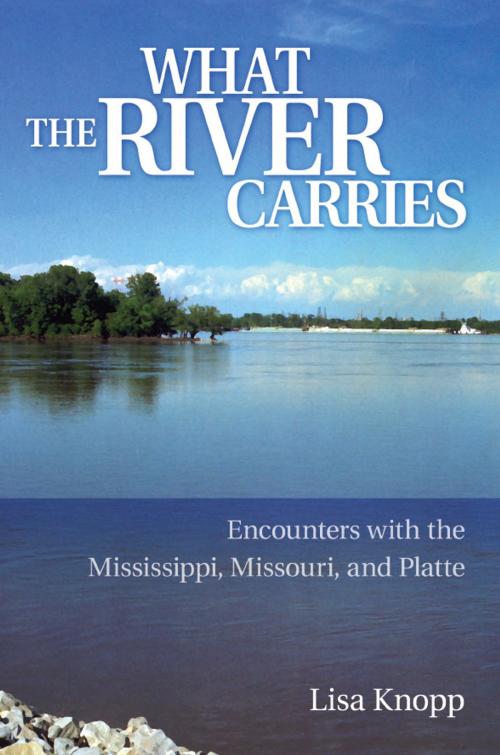What the River Carries
Encounters with the Mississippi, Missouri, and Platte
Nonfiction, Science & Nature, Nature, Environment, Rivers, Environmental Conservation & Protection| Author: | Lisa Knopp | ISBN: | 9780826272768 |
| Publisher: | University of Missouri Press | Publication: | May 18, 2012 |
| Imprint: | University of Missouri | Language: | English |
| Author: | Lisa Knopp |
| ISBN: | 9780826272768 |
| Publisher: | University of Missouri Press |
| Publication: | May 18, 2012 |
| Imprint: | University of Missouri |
| Language: | English |
In this informed and lyrical collection of interwoven essays, Lisa Knopp explores the physical and cultural geography of the Mississippi, Missouri, and Platte, rivers she has come to understand and cherish. At the same time, she contemplates how people experience landscape, identifying three primary roles of environmental perception: the insider, the outsider, and the outsider seeking to become an insider. Viewing the waterways through these approaches, she searches for knowledge and meaning.
Because Knopp was born and raised just a few blocks away, she considers the Mississippi from the perspective of a native resident, a “dweller in the land.” She revisits places she has long known: Nauvoo, Illinois, the site of two nineteenth-century utopias, one Mormon, one Icarian; Muscatine, Iowa, once the world’s largest manufacturer of pearl (mussel shell) buttons; and the mysterious prehistoric bird- and bear-shaped effigy mounds of northeastern Iowa. On a downriver trip between the Twin Cities and St. Louis, she meditates on what can be found in Mississippi river water—state lines, dissolved oxygen, smallmouth bass, corpses, family history, wrecked steamboats, mayfly nymphs, toxic perfluorinated chemicals, philosophies.
Knopp first encountered the Missouri as a tourist and became acquainted with it through literary and historical documents, as well as stories told by longtime residents. Her journey includes stops at Fort Bellefontaine, where Lewis and Clark first slept on their sojourn to the Pacific; Little Dixie, Missouri’s slaveholding, hemp-growing region, as revealed through the life of Jesse James’s mother; Fort Randall Dam and Lake Francis Case, the construction of which destroyed White Swan on the Yankton Sioux Reservation; and places that produced unique musical responses to the river, including Native American courting flutes, indie rock, Missouri River valley fiddling, Prohibition-era jazz jam sessions, and German folk music.
Knopp’s relationship with the Platte is marked by intentionality: she settled nearby and chose to develop deep and lasting connections over twenty years’ residence. On this adventure, she ponders the half-million sandhill cranes that pass through Nebraska each spring, the ancient varieties of Pawnee corn growing at the Great Platte River Road Archway Monument, a never-broken tract of tallgrass prairie, the sugar beet industry, and the changes in the river brought about by the demands of irrigation.
In the final essay, Knopp undertakes the science of river meanders, consecutive loops of water moving in opposite directions, which form around obstacles but also develop in the absence of them. What initiates the turning that results in a meander remains a mystery. Such is the subtle and interior process of knowing and loving a place. What the River Carries asks readers to consider their own relationships with landscape and how one can most meaningfully and responsibly dwell on the earth’s surface.
Winner of the 2013 Nebraska Book Award for Nonfiction
Honorable Mention for the Association for Literature and the Environment's 2013 Environmental Creative Nonfiction Award
In this informed and lyrical collection of interwoven essays, Lisa Knopp explores the physical and cultural geography of the Mississippi, Missouri, and Platte, rivers she has come to understand and cherish. At the same time, she contemplates how people experience landscape, identifying three primary roles of environmental perception: the insider, the outsider, and the outsider seeking to become an insider. Viewing the waterways through these approaches, she searches for knowledge and meaning.
Because Knopp was born and raised just a few blocks away, she considers the Mississippi from the perspective of a native resident, a “dweller in the land.” She revisits places she has long known: Nauvoo, Illinois, the site of two nineteenth-century utopias, one Mormon, one Icarian; Muscatine, Iowa, once the world’s largest manufacturer of pearl (mussel shell) buttons; and the mysterious prehistoric bird- and bear-shaped effigy mounds of northeastern Iowa. On a downriver trip between the Twin Cities and St. Louis, she meditates on what can be found in Mississippi river water—state lines, dissolved oxygen, smallmouth bass, corpses, family history, wrecked steamboats, mayfly nymphs, toxic perfluorinated chemicals, philosophies.
Knopp first encountered the Missouri as a tourist and became acquainted with it through literary and historical documents, as well as stories told by longtime residents. Her journey includes stops at Fort Bellefontaine, where Lewis and Clark first slept on their sojourn to the Pacific; Little Dixie, Missouri’s slaveholding, hemp-growing region, as revealed through the life of Jesse James’s mother; Fort Randall Dam and Lake Francis Case, the construction of which destroyed White Swan on the Yankton Sioux Reservation; and places that produced unique musical responses to the river, including Native American courting flutes, indie rock, Missouri River valley fiddling, Prohibition-era jazz jam sessions, and German folk music.
Knopp’s relationship with the Platte is marked by intentionality: she settled nearby and chose to develop deep and lasting connections over twenty years’ residence. On this adventure, she ponders the half-million sandhill cranes that pass through Nebraska each spring, the ancient varieties of Pawnee corn growing at the Great Platte River Road Archway Monument, a never-broken tract of tallgrass prairie, the sugar beet industry, and the changes in the river brought about by the demands of irrigation.
In the final essay, Knopp undertakes the science of river meanders, consecutive loops of water moving in opposite directions, which form around obstacles but also develop in the absence of them. What initiates the turning that results in a meander remains a mystery. Such is the subtle and interior process of knowing and loving a place. What the River Carries asks readers to consider their own relationships with landscape and how one can most meaningfully and responsibly dwell on the earth’s surface.
Winner of the 2013 Nebraska Book Award for Nonfiction
Honorable Mention for the Association for Literature and the Environment's 2013 Environmental Creative Nonfiction Award








![Cover of the book The Vanishing Newspaper [2nd Ed] by Lisa Knopp](https://www.kuoky.com/images/2009/september/300x300/9780826272034-5PcR_300x.jpg)






